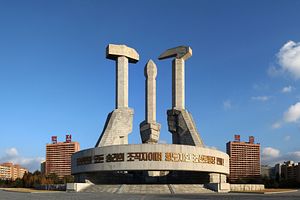The closest foreign journalists got to proceedings at the 7th Congress of the Workers’ Party of Korea was a view of the venue from outside.
After leading foreign media on tours of beautified sites across the capital earlier in the week, authorities kept reporters hundreds of meters away from the April 25 House of Culture as the meeting got underway.
Rather than updates on the most important political meeting in a generation, journalists who tuned into state television to supplement their understanding were greeted with orchestral performances and propaganda-heavy dramas.
For the 130-strong foreign media contingent specifically invited to cover the congress, there was little known about the event to report.
It’s assumed that Supreme Leader Kim Jong-un will use the first such meeting since 1980 to bolster his authority over the totalitarian state and chart its future course.
“We’re likely to see them definitively enshrine their nuclear weapons program in the preamble to the Party Charter, and they are likely to announce a continuation of missile development and testing,” Michael Madden, the author of North Korea Leadership Watch, told The Diplomat.
“We will also hear something about economic development. I don’t think Kim Jong-un will make any major policy initiatives but he will probably announce policy direction and some general guidelines about the economy and how they plan to develop it.”
Restricted in their reporting, foreign journalists readily acknowledged their unwitting roles in a script that blacks out the country’s grinding poverty and many alleged human rights abuses.
CNN’s Will Ripely, who has been prolific in sharing images of the capital’s most attractive locations on social media, told media website TV Newser he was “always mindful that we are being invited by the government with the intention of being used for propaganda purposes.”
At the Los Angeles Times, Beijing bureau chief Julie Makinen described her “role to play” in the production after visiting the Children’s Palace, where she heard teenagers barely old enough to shave proclaim their determination to battle “American imperialists and Japanese.”
On Periscope, The Washington Post’s Anna Fifield stressed the limits of her view as she walked Pyongyang’s streets, followed lockstep by her state-appointed minder.
“I am not in any way pretending that this is the real North Korea,” she said of the pleasant-looking, albeit rainy, cityscape.
For conscientious journalists, the experience highlighted the challenge of trying to glean genuine insights while being corralled and exploited for ulterior ends. On the first day of North Korea’s biggest political event in decades, however, even the briefest illuminating moment appeared beyond reach.

































